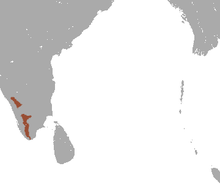Nilgiri langur
| Nilgiri langur | ||||||||||||
|---|---|---|---|---|---|---|---|---|---|---|---|---|

Nilgiri langur |
||||||||||||
| Systematics | ||||||||||||
|
||||||||||||
| Scientific name | ||||||||||||
| Semnopithecus johnii | ||||||||||||
| ( J. Fischer , 1829) |
The Nilgiri langur ( Semnopithecus johnii , syn .: Trachypithecus johnii ) is a primate species from the group of slender monkeys and is one of the two species into which the sub-genus violet-faced langurs ( Kasi ) is divided within the genus of Indian langurs ( Semnopithecus ).
features
Nilgiri langurs reach a head body length of 58 (females) to 78 (males) centimeters, the tail is with 69 to 97 centimeters significantly longer than the body. The weight varies between 10 and 14 kilograms, with the males becoming heavier than the females. The fur of these animals is colored black, the dark, hairless face is surrounded by light, yellowish-brown hair.
distribution and habitat
These primates live in southern India , mainly in the area of the Western Ghats in the eponymous Nilgiri Mountains . The habitat of these animals are forests, both deeper and mountain forests up to 2000 meters above sea level.
Way of life
Nilgiri langurs are diurnal tree dwellers that move in the branches mainly on all fours. They live in harem groups of 3 to 25 animals, these consist of a male, one or more females and their offspring. They are territorial animals that are aggressive towards other groups. The roaming areas are small and the length of the daily forays relatively short.
They are herbivores that feed mainly on leaves, but also eat fruits, seeds, flowers, buds and other parts of plants. Like all slim monkeys, they have a multi-chambered stomach for better utilization of the difficult to digest plant food.
Reproduction
The majority of births occur in the months of May to June or November, which is related to the increased growth of leaves after monsoons . Single births predominate, the young animals initially have a red-brown fur, which begins to turn black after a few weeks. The young animal is weaned when it is around one year old. The males have to leave their birth group when they reach sexual maturity.
threat
The main threats to the Nilgiri langur are habitat loss and hunting. Certain parts of the body of this primate are said to have healing properties, so their blood is drunk as a rejuvenating agent. Their settlement area is split up into many small parts, parts of which are protected as nature reserves. The IUCN estimates the number of adult animals at around 8,300 and lists the species as endangered ( vulnerable ). Outside of its Indian homeland, this species was only kept in the Erfurt Zoo (for more than 40 years) (since 2012 in the newly created "lemur forest"). With the death of the last two offspring in May and July 2016, however, this attitude ended.
Systematics
The Nilgiri langur, together with the white bearded langur of Sri Lanka, forms the subgenus Kasi within the Indian langurs . The systematic position of this sub-genus is controversial; they seem to mediate between the Hanuman langurs (genus Semnopithecus ) and the crested langurs (genus Trachypithecus ). The color of the newborns, which is otherwise a good criterion for the various species of langur, is also not clear for Kasi . Geissmann (2003) and Mittermeier, Rylands & Wilson (2013) classify the Nilgiri langur under Semnopithecus , Wilson & Reeder (2005), however, under Trachypithecus .
literature
- Thomas Geissmann : Comparative Primatology. Springer-Verlag, Berlin et al. 2003, ISBN 3-540-43645-6 .
- Russell A. Mittermeier , Anthony B. Rylands & Don E. Wilson : Handbook of the Mammals of the World: Primates: 3rd page 738, ISBN 978-8496553897
- Don E. Wilson, DeeAnn M. Reeder (Eds.): Mammal Species of the World. A taxonomic and geographic Reference. Johns Hopkins University Press, Baltimore MD 2005, ISBN 0-8018-8221-4 .
Web links
- Trachypithecus johnii in the endangered Red List species the IUCN 2006. Posted by: Participants of CBSG CAMP Workshop: Status of South Asian Primates, 2004. Accessed April 28 of 2008.
- Information on Theprimata.com
- Information and photo at arkive.org
Individual evidence
- ↑ Nilgiri langur. In: zootierliste.de. Retrieved August 29, 2016 .
